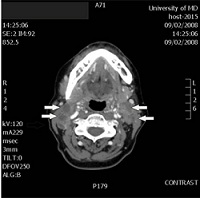 |
| The arrows point to cancerous lymph nodes on both sides of the neck.--Courtesy of the National Cancer Institute |
Head and neck cancers account for a small portion of the total cancer cases in the U.S.--about 3% to 5%, according to the American Cancer Society--but the survival rate for squamous cell carcinoma, the most common type of head and neck cancer, is very low.
A new drug combination created by researchers at Emory University in Atlanta could provide an effective prevention approach to high-risk patients, which can be easily identified by their advanced oral precancerous lesions.
Alcohol and tobacco use is the most common risk factor in the U.S., but head and neck cancer is also sometimes caused by HPV infection, which can affect the tonsils.
Using previous research suggesting that epidermal growth factor receptor (EGFR) and cyclooxygenase-2 (COX-2) play a role in promoting squamous cell carcinoma of the head and neck, the researchers combined an EGFR inhibitor and a COX-2 inhibitor with the hope of creating an effective chemopreventive therapy.
The drug cocktail was effective at inhibiting the growth of human squamous cell carcinoma cell lines compared with either drug alone. The researchers then tested the drug combo in mice, and found that the drugs worked even better in mice when administered before the human cancer cells were transplanted.
The biggest concern with this particular drug combo is the toxicity level, research leader Dong Moon Shin, director of the Cancer Chemoprevention Program at Emory's Winship Cancer Institute, told FierceBiotechResearch.
The researchers tested the therapy's efficacy in a small Phase I chemotherapy trial, in which 11 patients were given the drug combo. Several patients dropped out of the study because of adverse side effects, including skin rash, but three of the 7 patients that remained in the study exhibited no evidence of precancerous lesions in the follow-up biopsy sample.
Still, it's back to the drawing board for Shin and his colleagues.
"Hopefully we can achieve similar goals with less toxic agents," Shin said in an interview. His team is also looking into creating cancer-fighting therapies from compounds found in green tea, red wine and green vegetables to treat head and neck cancers.
- read the news release